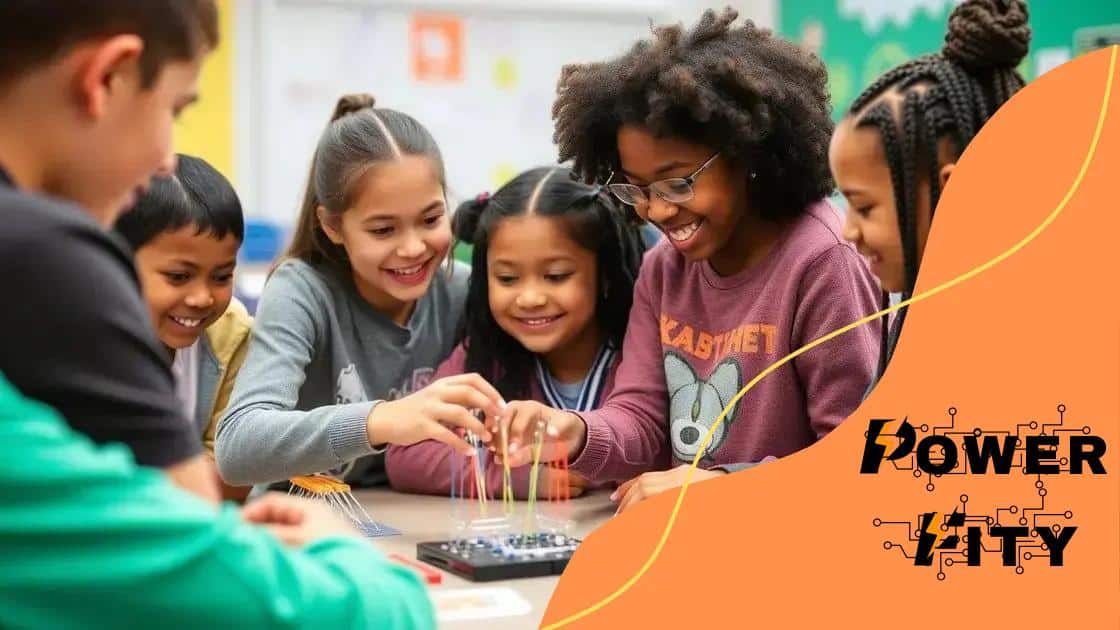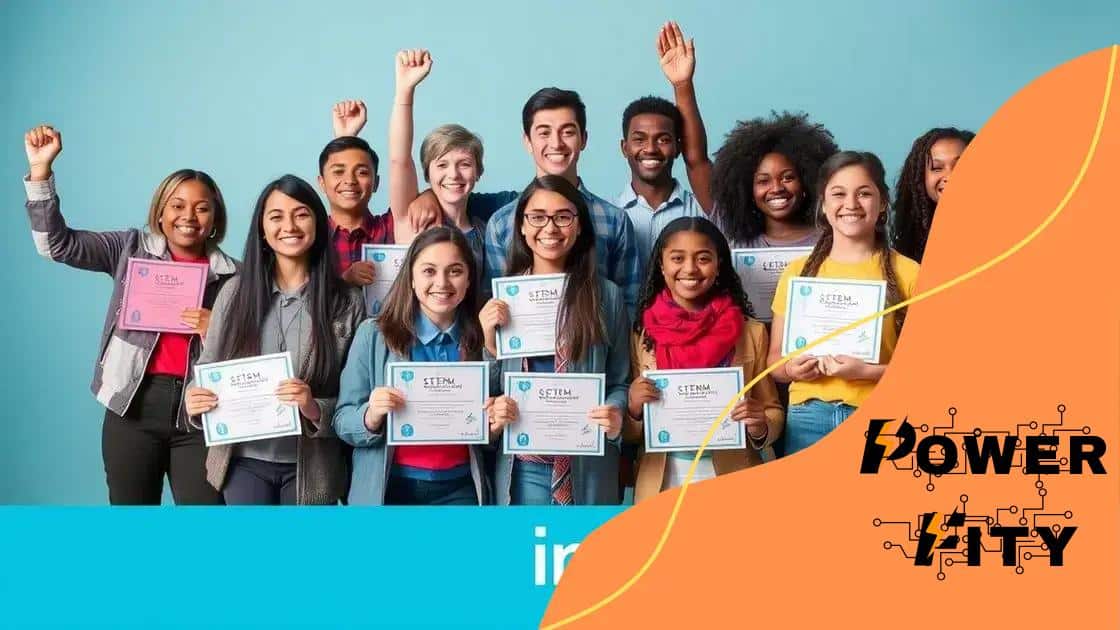STEM programs for girls and underrepresented students: A game changer

STEM programs for girls and underrepresented students provide essential skills and opportunities, fostering diversity and encouraging future leaders in science, technology, engineering, and math fields.
STEM programs for girls and underrepresented students are stepping up to bridge the gap in tech and science fields. Have you noticed how crucial these initiatives are for fostering creativity and equality? Let’s dive into their profound impact!
Understanding the importance of diversity in STEM
Diversity in STEM is essential for fostering innovation and creativity. When different perspectives come together, they often lead to groundbreaking ideas. Understanding the importance of diversity in STEM means recognizing how varied backgrounds enrich problem-solving processes.
Why Diversity Matters
Having people from different cultures, genders, and experiences in STEM fields creates a more dynamic work environment. This blend of backgrounds can significantly enhance the ways teams approach challenges. For example, diverse teams are more adaptable and open to exploring new solutions.
- Increases creativity and innovation.
- Improves team performance.
- Enhances decision-making processes.
Additionally, exposure to a range of ideas can inspire individuals in STEM to think differently. When students see role models who look like them, it motivates them to pursue careers in these fields. Increasing representation is a key step in making STEM more inclusive.
Building Inclusive Environments
To fully realize the benefits of diversity, educational institutions and organizations must create welcoming environments. This includes providing resources and support systems tailored to underrepresented groups. Furthermore, training programs that emphasize the value of diversity can help shift organizational cultures towards inclusivity.
- Implement mentorship programs.
- Encourage collaborative projects.
- Offer scholarships for underrepresented students.
Engaging more girls and underrepresented students in STEM can pave the way for a more equitable future. Ultimately, understanding the importance of diversity is not just about numbers; it’s about changing perspectives and breaking barriers.
Top STEM programs for girls
There are many amazing STEM programs designed specifically for girls. These programs encourage young women to explore science, technology, engineering, and mathematics.
Why Focus on Girls in STEM?
Engaging girls in STEM is vital because women have been historically underrepresented in these fields. Programs targeted at girls help to inspire confidence and showcase role models. Additionally, they create supportive environments where young women can thrive and excel.
- Access to mentorship opportunities.
- Encouragement to pursue advanced studies.
- Exposure to various STEM careers.
One popular program is the Girls Who Code initiative. This program aims to close the gender gap in technology by teaching girls programming and computer science skills while promoting teamwork and creativity. Participants engage in hands-on projects that allow them to express their unique ideas.
Other Notable Programs
Another fantastic option is the American Association of University Women (AAUW), which offers STEM education programs and scholarships for girls. This organization not only supports girls in their academic pursuits but also provides a platform for networking and professional growth.
- STEM camps focused on hands-on learning.
- Workshops to build technical skills.
- Scholarships for higher education in STEM fields.
Additionally, local community centers often host workshops and summer camps that inspire girls to explore STEM. These opportunities provide fun, interactive learning experiences, making science and math exciting and attractive.
Overall, these top STEM programs for girls are crucial in helping to cultivate the next generation of women leaders in these essential fields.
Success stories from underrepresented students

Success stories from underrepresented students in STEM showcase the power of determination and talent. These inspiring individuals break barriers and serve as role models for others.
Stories of Triumph
Many students from diverse backgrounds face unique challenges in pursuing their STEM education, yet their resilience shines through. For instance, Maria, a young woman from a low-income neighborhood, received a scholarship to a prestigious science program. Through hard work and dedication, she not only excelled academically but also became a mentor for younger girls interested in science.
- Maria’s story highlights the importance of support systems.
- Her mentorship ignited interest in STEM among her peers.
- Scholarships can change lives by providing opportunities.
Similarly, Jamal, an African American student, overcame several obstacles to study engineering. He found support in programs that focused on diversity and inclusion. With the encouragement of his teachers and the community, Jamal participated in coding competitions, where he won several awards.
The Impact of Representation
These stories emphasize how representation plays a crucial role in motivating future generations. When students see individuals who look like them achieving success in STEM, it can inspire them to pursue their own dreams. As more underrepresented students share their journeys, it fosters a sense of belonging and possibility within the field.
- Representation encourages young women and minorities.
- Community support helps build confidence.
- Networking can open doors to internships and jobs.
The irreplaceable voices of underrepresented students in STEM not only uplift their communities but also enrich the fields they enter. Their success stories remind us that anyone can achieve their dreams with determination and the right support.
How schools can support STEM initiatives
Schools play a vital role in supporting STEM initiatives. They can create an environment that fosters interest and engagement in science, technology, engineering, and mathematics for all students.
Creating STEM-focused Programs
One way schools can support STEM initiatives is by developing dedicated programs. These programs can introduce students to hands-on experiences in coding, robotics, and scientific research. For example, after-school clubs focused on these topics can spark interest and build skills outside the traditional classroom setting.
- Encouraging participation in science fairs.
- Organizing coding challenges and hackathons.
- Providing workshops led by industry professionals.
Moreover, partnerships with local organizations and businesses can greatly enhance these programs. Schools can collaborate with museums, tech companies, and universities to provide real-world experiences.
Emphasizing Inclusive Education
Another way to boost STEM initiatives is by emphasizing inclusivity. Schools should ensure that girls and underrepresented students have access to these programs. Mentorship opportunities can help inspire these students to pursue STEM paths.
- Invite guest speakers from diverse backgrounds.
- Provide scholarships for STEM camps.
- Implement peer mentoring programs.
Integrating diversity in STEM education not only enriches learning but also leads to better outcomes for all students. By showcasing success stories, schools can motivate students and create a more equitable environment.
Finally, training teachers to integrate STEM into everyday lessons is crucial. Professional development workshops can equip educators with the tools they need to bring exciting science and math lessons to life. The more teachers understand these concepts, the more effectively they can inspire their students.
Future trends in STEM education
The future of STEM education is looking bright and full of exciting opportunities. As technology advances, educational approaches are evolving to engage students more effectively.
Integration of Technology
One significant trend is the integration of technology in classrooms. Virtual reality (VR) and augmented reality (AR) tools allow students to explore complex concepts in a more interactive way. For example, students can take virtual field trips to space or dive into the human body, making learning hands-on.
- Enhancing understanding of scientific concepts.
- Increasing student engagement through immersive experiences.
- Supporting various learning styles effectively.
Furthermore, coding, data analysis, and robotics are becoming essential parts of the curriculum. Schools are recognizing the importance of teaching these skills early on to prepare students for future careers.
Emphasis on Collaboration
Another key trend in STEM education is the emphasis on collaboration. Group projects encourage teamwork and communication skills, which are critical in the modern workplace. When students work together, they learn to solve problems collectively and share diverse perspectives.
- Collaboration nurtures creativity and innovation.
- Fosters a sense of community among students.
- Prepares students for real-life challenges in careers.
Additionally, schools are focusing on creating inclusive environments that support diverse learners. This means adapting teaching methods to ensure that all students, regardless of background, have equal access to STEM opportunities.
Moreover, online learning platforms are gaining momentum. They provide flexible and accessible resources for students to learn at their own pace, which is especially helpful in a rapidly changing technological landscape.
As we look ahead, it is clear that STEM education will continue to evolve. By incorporating new technologies and emphasizing collaboration, schools can prepare students for future success in STEM fields.
\n
FAQ – Frequently Asked Questions about STEM Programs for Girls and Underrepresented Students
Why are STEM programs important for girls and underrepresented students?
STEM programs empower girls and underrepresented students with skills and opportunities to succeed in science, technology, engineering, and math careers.
What types of STEM programs can schools offer?
Schools can offer coding workshops, robotics clubs, science fairs, and partnerships with local businesses to provide hands-on learning experiences.
How can mentorship benefit girls in STEM?
Mentorship provides guidance, support, and role models for girls, helping them navigate their interests in STEM fields and boosting their confidence.
What role does technology play in modern STEM education?
Technology enhances STEM education by providing interactive tools like VR and AR, making complex concepts easier to understand and engage with.





